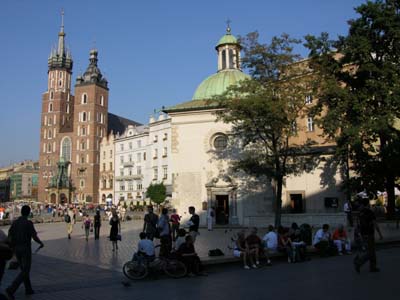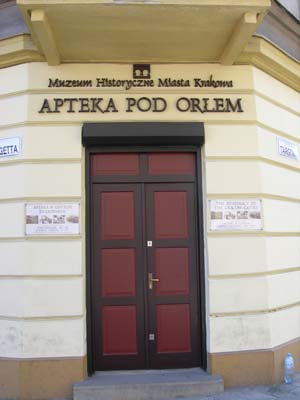
To go to Krakow, I made a
detour to visit some sights. The very tourist village of
Kazimierz Dolny has on the place of the market the house of the
Przybylo brothers built at the XVIIth century in a very free Renaissance
style.
The town of Lezajsk has a
monastery, Bazylika I Klasztor Bernardynow, whose church is decorated
with Baroque frescos in a set of black columns and golden statues; the effect
is impressive.
Finally the town of
Lancut is re-elected for its castle built as of XIVth century then
increased and embellished by Lubomirski and Potocki. It is also known for
Polmos distilling of vodka.
Krakow is one of the rare medieval cities of Poland which is not a rebuilding. Founded as of Xth century, it was ransacked by Tatars in 1241. Since any invader did not destroy the sumptuous harmony of the old city. The city is visited in three stages, the old city, the Wawel hill and finally the Kazimierz district.
The old city surrounded by gardens in the place of the old ramparts and the ditches opens in the north by the Florian gate protected by a barbakan, strengthened bastion. It is dominated in the south by the Wawel hill and the castle. Beside the many religious buildings and middle-class residences, it has the Jagiellonski University founded into 1364 which acquired a European fame for in particular Nicolas Copernic.

The Notre-Dame church and the
small Saint-Adalbert church
the last rebuilding of
Notre-Dame goes back to 1355

Rynek Glowny place, the
market with cloths and the tower of the Town hall
It is the vastest place of the Middle Ages, 200m on
side

The Kanonicza street
It preserved the
residences patricians
with the Gothic
and Renaissance frontages

The Saint-Pierre
and Saint-Paul church
the twelve apostles assemble the guard in
front of the church
The Wawel hill was selected as of Xth century for the construction of a castle and a cathedral of Roman style. Several times rebuilt afterwards of the fires, they owe their current form with the style in XIVth century. Until the XVIIth century they were the political and religious centre of Poland.

The
cathedral
its last rebuilding goes
back to 1364

The castle
rebuilt in 1499 in the Renaissance
style

The interior courtyard of the
castle
The Kazimierz district was creates by the king Kazimierz III to accommodate the expropriate Jewish community of the old city to release the grounds required by the construction of the Jagiellonski university. The town of Kazimierz gathered two religious communities, Christian and Jewish, but already separated by a wall!

The Baroque synagogue Ajzyk
or Isaac
synagogue

The pharmacy of the
ghetto
well-known since a film of
Stephen Spielberg

Très-Saint-Corps-du-Christ church
Stalls,
Baroque style
The visit of the town of Krakow
was an enchantment by the number and the variety of the monuments to be
visited. The two days allowed, alas, only one overview of the inheritance of this secular city.
The tow path of Wisla is a very appreciated place of walk by the
inhabitants of Krakow. I traversed it with bicycle.